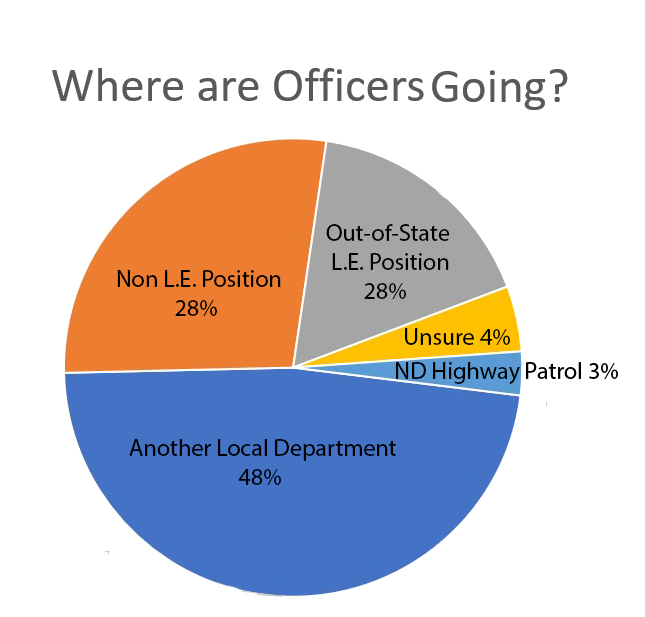NDACo News
NDACo News
Local Law Enforcement Departments Struggle with Recruiting and Retaining Officers
Posted 3/04/22 (Fri)
Donnell Preskey | Government/Public Relations Specialist
The workforce shortage is hitting one of the most critical fields to ensure the safety of North Dakota citizens. According to a recent survey conducted by the North Dakota Association of Counties (NDACo), 11% of local law enforcement positions were open at the beginning of 2022; 69% of those positions were open for one month or longer. Sixty-six agencies responded to the survey providing data from sheriffs’ offices, jails, and police departments. The survey was conducted to provide data to the Interim Government Finance Committee study on recruitment and retention of law enforcement. NDACo Government Affairs Specialist Donnell Preskey presented the survey results to the committee earlier this month.
“The 136 positions that are open across the state in local departments may not sound like a high number, but each number represents an individual that is not responding to a call, patrolling county roads, or working in the jail. This most certainly impacts public safety,” testified Preskey.
The data collected is interesting, and good to have, but it doesn’t tell us anything we didn’t already know. It is a struggle to find men and women to enter the law enforcement field. These are high stress, highly scrutinized jobs with schedules that are less than desirable. In addition, local departments have a difficult time competing with salaries in other professional fields.
The average local law enforcement officer is 35 years old and serves for 7.4 years. 80% of the employees serving in sheriffs’ offices and jails have under 10 years of experience. This obviously illustrates the degree of churn in employees.
In 2021, most of the responding agencies experienced a less than 5% turnover ratio; however, a substantial number of agencies experienced somewhere between 11% and 49% turnover. Based on the responses and narratives provided by sheriffs and chiefs, the struggle of dealing with vacant positions is constant. Almost 60% indicated that they “always” or “usually” have a delay in filling positions because of lack of applicants and interest. Even more concerning is that nearly half of the respondents said they have filled a position with an under-qualified individual to fill a position.
The survey asked sheriffs, chiefs and jail administrators to rank why they believe officers were leaving their jobs. Pay was the greatest reason. The other reasons (burnout, not right fit, schedule, lack of advancement, location, benefits, medical issues) were ranked evenly. According to the latest NDACo Salary Survey, the average salary for our county law enforcement folks serving at the sheriffs’ offices and jails is $58,000.
A significant discrepancy is evident when you compare the salary ranges in small versus large counties. For example, a chief deputy in Griggs County makes $42,000 while a chief deputy in Williams County makes nearly three times as much. This illustrates how the strain to retain officers is likely greater in those rural counties, especially those located near larger jurisdictions that provide greater opportunities for advancement. The issue is exacerbated in rural settings that tend to require longer hours, more on-call, and where there is a lack of housing.
 Most local law enforcement are leaving their agency for another local department, highlighting the competition for these positions within our state and between departments. The second greatest draw is a non-law enforcement position.
Most local law enforcement are leaving their agency for another local department, highlighting the competition for these positions within our state and between departments. The second greatest draw is a non-law enforcement position.
Sheriffs, chiefs and jail administrators ranked pay and benefits as the top assets in retaining officers. In addition, almost half of the respondents commented that increasing pay and benefits was a necessary strategy to attract and retain workers.
51 of the 53 counties are in the PERS system, 21 of these have their law enforcement personnel enrolled in the Public Safety Retirement Plan while the remaining 30 are enrolled in the NDPERS main plan. According to the NDACo Salary Survey – 22 counties pay 100% of the employer and employee share of the retirement responsibility. 38 counties pay 80% or above, resulting in 2/3 of all county employees having 80% or more of their retirement paid for by the county.
In relation to health insurance benefits, 36 counties offer 100% paid single health insurance plans and more than half our counties (31) pay 80% or more of a family health insurance plan.
 “North Dakota counties are competitive with pay and benefits and have done what they can to create flexibility with schedules, but the problem still exists,” commented Preskey. “The data defines the problem we have in North Dakota, but the big question is what is the state’s role in addressing this issue, especially at the local level.”
“North Dakota counties are competitive with pay and benefits and have done what they can to create flexibility with schedules, but the problem still exists,” commented Preskey. “The data defines the problem we have in North Dakota, but the big question is what is the state’s role in addressing this issue, especially at the local level.”
Preskey outlined potential solutions that are being proposed or adopted in other states along with concepts from local legislators and law enforcement. Those possible solutions include:
- Income tax exemption (Georgia)
- Income tax exemption on retirement income
- Hiring bonus (Tennessee)
- Retention bonus
- State contribution into NDPERS Public Safety Retirement Plan
- Scholarship program (Maryland – state pays half tuition)
- Florida public safety recruitment & retention plan (multitude of items including a $5,000 bonus for experienced law enforcement who locate to Florida)
NDACo looks forward to working with the Interim Government Finance Committee or any other legislators to develop concepts to bring forward for consideration during the 2023 Legislative Session.

 Find County Officials
Find County Officials